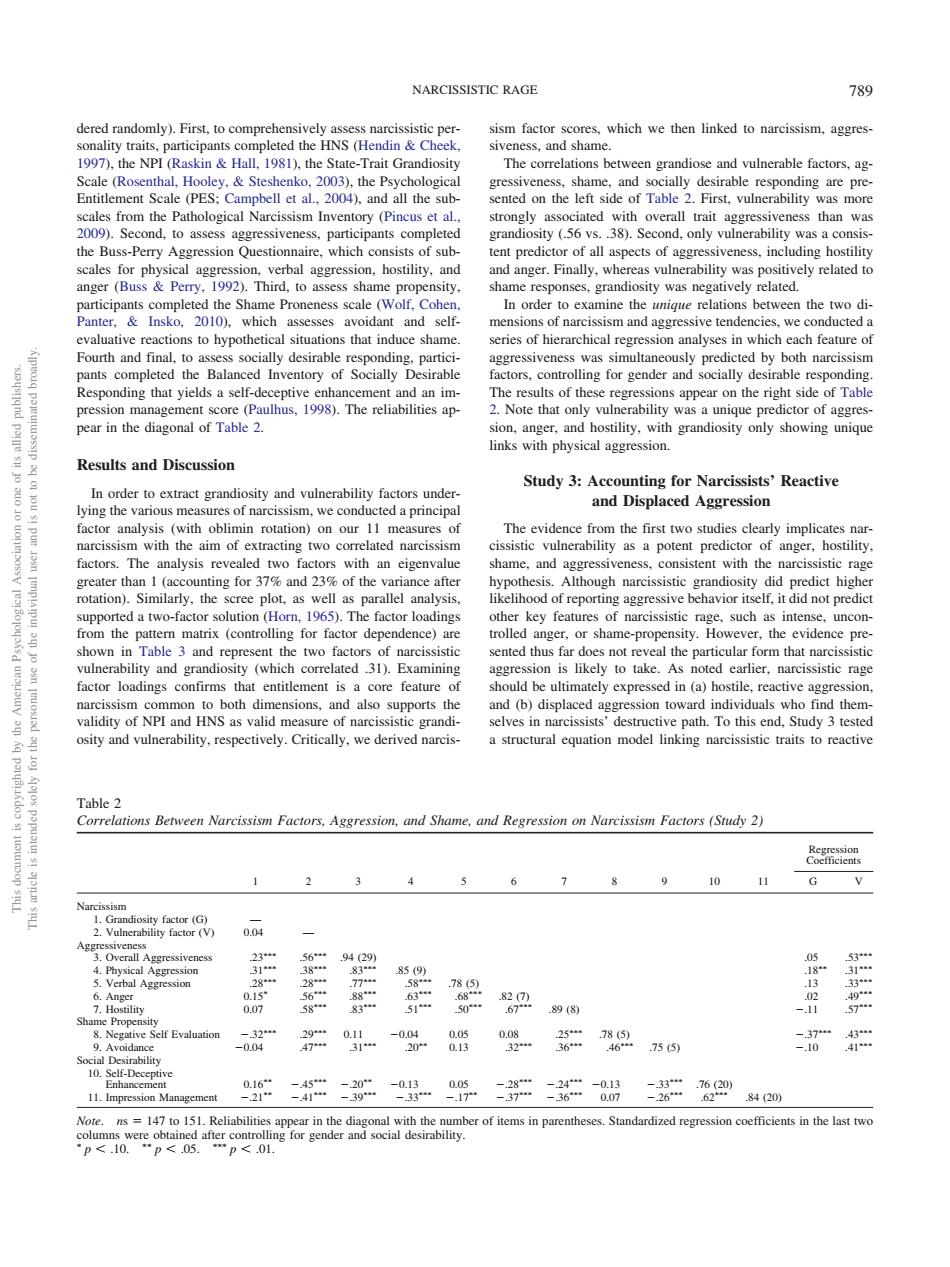正在加载图片...

NARCISSISTIC RAGE 789 997).the NPI (Raskin Hall.1981).the State-Trait Grandiosit The correlations between grandiose and vulnerable factors,ag Ste sm Inventory (Pincus et al trongly asse iated with overall trait ss than wa he Buss-Pem rticinan me pro esscale (Wolf,Cohe In order to examine the uigue relations between the two di Insko.2010). odant and m and aggres ggress eness a ously predicted by both narcissism ng for gender and tor of aggre grandiosity only showing uniqu Results and Discussion Study 3:Ac analysis (with oblimin rotation) on ou The evidence from the first two studies clearly implica nar actors ed two with and ag with the re ccounting for 3 and 23%of the id predict hig rted a two-fac (Horn.1965).The factor th such as inte e-propensity. and grand ggres ion is likely to take.As noted ntitlement is ately expres ed in (a)h idity of NPI and HNS as valid mea e path.To this end.Study 3 tes lty,respectively.Cri ically.we derived na and shame and regression on narcissism factors (smudy 2) 2 5 7 9 10 G V 004 9.Avo 290-0208 二5 11.Impression Management 06二45二2-005二3二20二37620 帐 dered randomly). First, to comprehensively assess narcissistic personality traits, participants completed the HNS (Hendin & Cheek, 1997), the NPI (Raskin & Hall, 1981), the State-Trait Grandiosity Scale (Rosenthal, Hooley, & Steshenko, 2003), the Psychological Entitlement Scale (PES; Campbell et al., 2004), and all the subscales from the Pathological Narcissism Inventory (Pincus et al., 2009). Second, to assess aggressiveness, participants completed the Buss-Perry Aggression Questionnaire, which consists of subscales for physical aggression, verbal aggression, hostility, and anger (Buss & Perry, 1992). Third, to assess shame propensity, participants completed the Shame Proneness scale (Wolf, Cohen, Panter, & Insko, 2010), which assesses avoidant and selfevaluative reactions to hypothetical situations that induce shame. Fourth and final, to assess socially desirable responding, participants completed the Balanced Inventory of Socially Desirable Responding that yields a self-deceptive enhancement and an impression management score (Paulhus, 1998). The reliabilities appear in the diagonal of Table 2. Results and Discussion In order to extract grandiosity and vulnerability factors underlying the various measures of narcissism, we conducted a principal factor analysis (with oblimin rotation) on our 11 measures of narcissism with the aim of extracting two correlated narcissism factors. The analysis revealed two factors with an eigenvalue greater than 1 (accounting for 37% and 23% of the variance after rotation). Similarly, the scree plot, as well as parallel analysis, supported a two-factor solution (Horn, 1965). The factor loadings from the pattern matrix (controlling for factor dependence) are shown in Table 3 and represent the two factors of narcissistic vulnerability and grandiosity (which correlated .31). Examining factor loadings confirms that entitlement is a core feature of narcissism common to both dimensions, and also supports the validity of NPI and HNS as valid measure of narcissistic grandiosity and vulnerability, respectively. Critically, we derived narcissism factor scores, which we then linked to narcissism, aggressiveness, and shame. The correlations between grandiose and vulnerable factors, aggressiveness, shame, and socially desirable responding are presented on the left side of Table 2. First, vulnerability was more strongly associated with overall trait aggressiveness than was grandiosity (.56 vs. .38). Second, only vulnerability was a consistent predictor of all aspects of aggressiveness, including hostility and anger. Finally, whereas vulnerability was positively related to shame responses, grandiosity was negatively related. In order to examine the unique relations between the two dimensions of narcissism and aggressive tendencies, we conducted a series of hierarchical regression analyses in which each feature of aggressiveness was simultaneously predicted by both narcissism factors, controlling for gender and socially desirable responding. The results of these regressions appear on the right side of Table 2. Note that only vulnerability was a unique predictor of aggression, anger, and hostility, with grandiosity only showing unique links with physical aggression. Study 3: Accounting for Narcissists’ Reactive and Displaced Aggression The evidence from the first two studies clearly implicates narcissistic vulnerability as a potent predictor of anger, hostility, shame, and aggressiveness, consistent with the narcissistic rage hypothesis. Although narcissistic grandiosity did predict higher likelihood of reporting aggressive behavior itself, it did not predict other key features of narcissistic rage, such as intense, uncontrolled anger, or shame-propensity. However, the evidence presented thus far does not reveal the particular form that narcissistic aggression is likely to take. As noted earlier, narcissistic rage should be ultimately expressed in (a) hostile, reactive aggression, and (b) displaced aggression toward individuals who find themselves in narcissists’ destructive path. To this end, Study 3 tested a structural equation model linking narcissistic traits to reactive Table 2 Correlations Between Narcissism Factors, Aggression, and Shame, and Regression on Narcissism Factors (Study 2) 1 2 3 4 5 6 7 8 9 10 11 Regression Coefficients G V Narcissism 1. Grandiosity factor (G) — 2. Vulnerability factor (V) 0.04 — Aggressiveness 3. Overall Aggressiveness .23 .56 .94 (29) .05 .53 4. Physical Aggression .31 .38 .83 .85 (9) .18 .31 5. Verbal Aggression .28 .28 .77 .58 .78 (5) .13 .33 6. Anger 0.15 .56 .88 .63 .68 .82 (7) .02 .49 7. Hostility 0.07 .58 .83 .51 .50 .67 .89 (8) .11 .57 Shame Propensity 8. Negative Self Evaluation .32 .29 0.11 0.04 0.05 0.08 .25 .78 (5) .37 .43 9. Avoidance 0.04 .47 .31 .20 0.13 .32 .36 .46 .75 (5) .10 .41 Social Desirability 10. Self-Deceptive Enhancement 0.16 .45 .20 0.13 0.05 .28 .24 0.13 .33 .76 (20) 11. Impression Management .21 .41 .39 .33 .17 .37 .36 0.07 .26 .62 .84 (20) Note. ns 147 to 151. Reliabilities appear in the diagonal with the number of items in parentheses. Standardized regression coefficients in the last two columns were obtained after controlling for gender and social desirability. p .10. p .05. p .01. This document is copyrighted by the American Psychological Association or one of its allied publishers. This article is intended solely for the personal use of the individual user and is not to be disseminated broadly. NARCISSISTIC RAGE 789����������������������������������������������������������������������������������������������������������������������������������������������������������������������������������